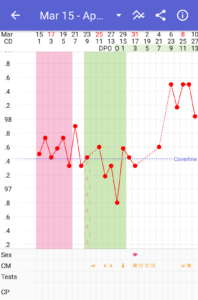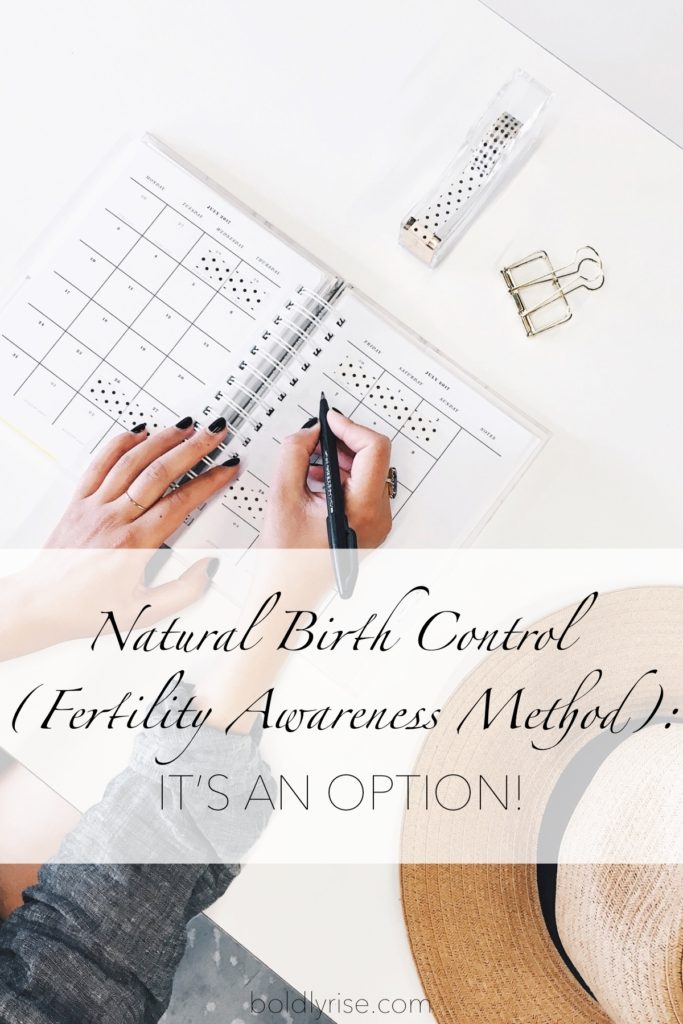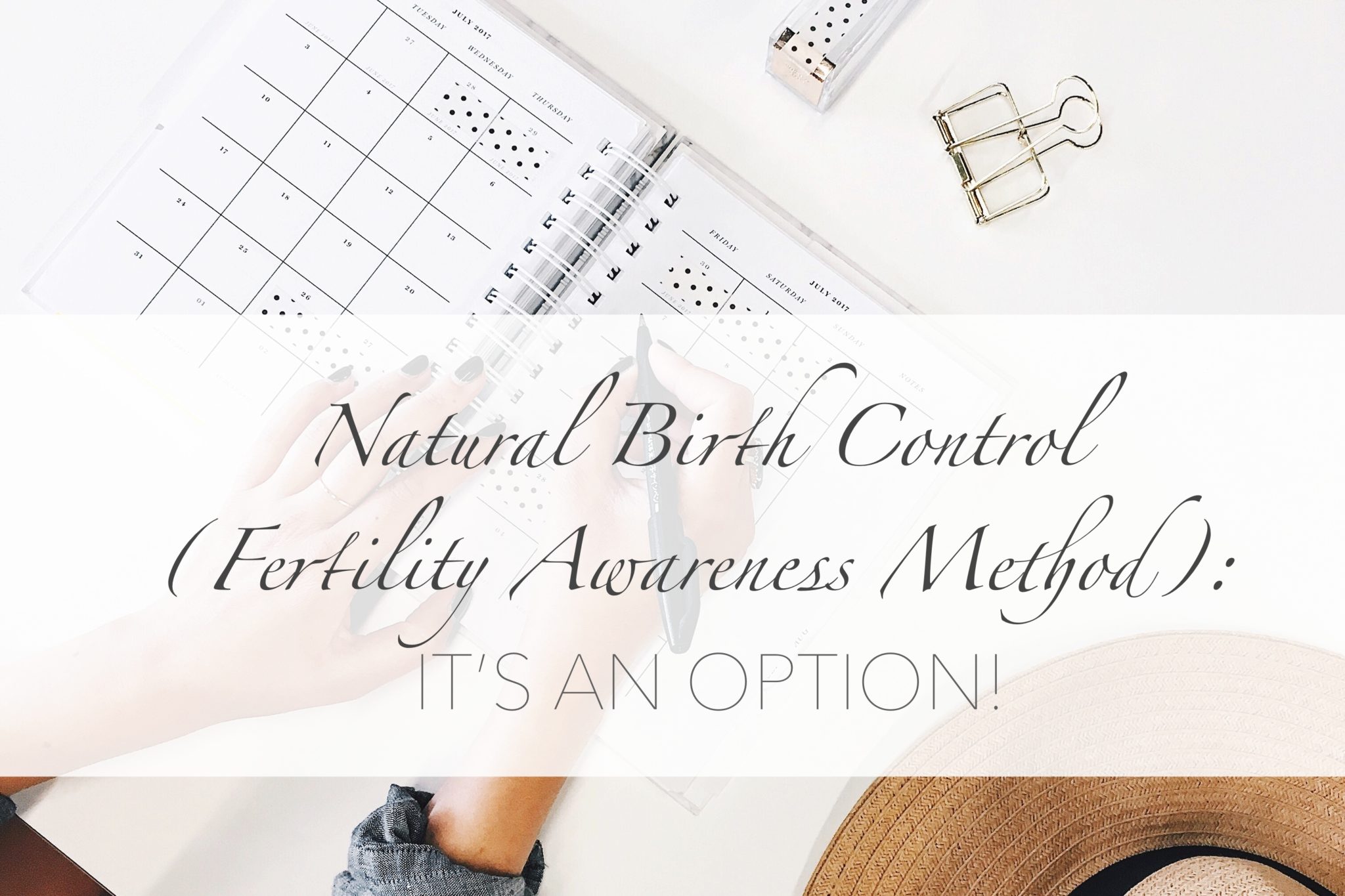Natural birth control…it’s a real thing! You aren’t limited to the world of hormonal birth control forms (pills, inserts, shots, etc.). You have the choice to know what’s going in your body and what’s going on in your body. I want you to know that you have choices when it comes to waiting to get pregnant, that you don’t have to navigate blindly through the mysteries of birth control wondering if there was something else you could be doing.
Before I got married, I thought that the only way to keep from having kids too early in our marriage, without being abstinent, was to go on hormonal birth control. Because I didn’t want to get shots or something surgically implanted, I thought my only option were birth control pills. For about 9 months I took the pill. The longer I was on it, the more I couldn’t help but feel that I needed to stop taking them and the more I wondered whether there was something out there that I could be doing that wasn’t thrashing my regularity.
Before I was on birth control, my cycles were always regular. But the second I started taking birth control pills, my cycles inversed: 3 weeks on my period, 1 week off… as you can imagine, that was not fun! I wanted so bad to find a way to keep from having kids while also helping my body rather than harming it. It wasn’t until a lovely friend told me about natural birth control – something she and her husband used for a long time until they knew it was the right time to have kids. Though I so wished that I had known this earlier, God, in His perfect timing, showed me the other option. And you have that option too.
Natural Birth Control: The Fertility Awareness Method
Natural birth control uses natural resources to help lower the chances of getting pregnant. The most common form of natural birth control to use is the Fertility Awareness Method (FAM) – the method my husband and I use. It uses your own body to tell you when you are fertile and when you are not. Your body gives you signs in three different ways: body temperature, cervical mucus, and timing. Keeping track of these three areas helps to know what stage your body is in.
The Three Methods
Each method pertains to the signs that your body gives you to tell you if and when you are ovulating (the dropping of an egg into your fallopian tube, allowing sperm to meet up with it to potentially make a baby). There are three main methods: the temperature method, the cervical mucus method, and the calendar method. However, if you are currently on hormonal birth control, you cannot use these methods because the birth control will interfere.
The Temperature Method
Our body’s go through two phases, one before ovulation and one after. The first phase is the follicular phase. It stretches from the first day of your period to the end of your ovulation. During this phase, your temperature will remain a little lower, anywhere between 97.0 and 97.7 Fahrenheit (this is the average, it may look a little different for you). The second phase is called the luteal phase. After ovulation, your body temperature rises just a little, anywhere between 97.7 and 98.4 Fahrenheit – this is because of an increase in progesterone levels (again, this may look a little different for you). Many times, on the day you ovulate, your temperature will do a sudden decrease by a few points.
Tracking your temperature changes helps show when you are “safe”/unfertile. Typically the rule of thumb here is that three days after a consistent rise in temperature, you are considered “safe.” Notice how during this month for me (the picture below), I had a day where I dropped temperature just a little down to 96.80 degrees signifying that day as my ovulation day. Then had an increase in temperature after I was done ovulating (I didn’t do well tracking right after ovulation – I think I was traveling, which can affect your temperature).
In order to track it, you’ll need a basal thermometer – a thermometer that shows you two decimal points. Check your temperature in the morning right after you wake up. Basal temperature is your body’s temperature at rest. And the best consistent time to get this is when you wake up, before you get out of bed and start doing anything. I got my basal thermometer at Target for about $7. (That’s a lot better than the $30 I was spending every month for the pill).

The Cervical Mucus Method
I know that this method may sound a little gross, but it’s a great indicator as to when you’re safe and unsafe (not fertile and fertile). As you go through your cycle, your cervical mucus (CM) changes from dry to wet. It’s not instantaneous; there are 6 different patterns: menstruation, dry/none, sticky, creamy, egg white, and watery. Then it reverses after you ovulate.
Menstruation –> dry –> sticky –> creamy –> egg white –> watery –> creamy –> sticky –> dry –> menstruation
As your estrogen levels increase, the more watery your cervical mucus/fluid becomes. The sticky pattern indicates that you are now likely fertile. Even though you won’t be ovulating yet, sperm can live up to six days in the mucus – therefore, six days before you ovulate (possibly a sticky day), you’ll have a small percentage of becoming pregnant. When you are seeing/feeling egg white, slippery, and/or wet cervical fluid, you’re extremely close to ovulation or ovulating that day.
Two general rules of thumb here. First, any dry days, days where you don’t experience hardly any cervical fluid, are considered safe days. Second, four days after your Peak Day (your most fertile day, usually occurring the day or two before or the day of ovulation, indicated by the last egg white/wet cervical mucus day) you are considered safe. This is because you may not actually ovulate until two days after Peak Day and your ovulation can span two more days (because you can drop two eggs, one after the other and both can survive for 24 hours).
Simply writing down each day what your cervical fluid looks/feels like will give you a good idea of when you’re fertile and when you’re not.
The Calendar Method
For those of you that have cycles less than 27 days, this method may not be a good fit for you. If you’re not sure what your average cycle days are, add the number of days between the first day of your period to the first day of your next period. The recommended least number of times to chart this to be sure is six cycles (six months-ish).
To use this method, there are two steps. First, take your shortest charted cycle and subtract 18 days. Whatever that number is, count from the first day of your period/cycle that number and put an X on it. This marks the beginning of your fertility. Second, take your longest charted cycle and subtract 11. Whatever that number is, count from the first day of your period/cycle that number and put another X on it. This marks the last day in your fertility window.
Example: shortest cycle – 27 days; longest cycle – 30 days. 27-18=9. 30-11=19. Days 9-19 are your fertile window. Notice in the picture below how this app (Glow) is tracking my period days in pink, my fertile days in green, and my predicted period days in light pink.
This method is based on predictions, not actualities. Only using this method without the others increases your chance of getting pregnant.

How good are my chances of using the FAM to not get pregnant?
I would say pretty good, that is if you combine all three methods and use them together. One method on its own will lower the percentage of preventing pregnancy (but I still think it’s way better than using hormonal birth control). If you use all three methods together, you have a 99.6% chance of preventing pregnancy! That’s if you’re using it constantly and correctly. The more inconsistent and incorrectly you use these methods, the lower the percentage of preventing pregnancy.
Get in the know
I hope you haven’t run off quite yet because of all the information I just threw at you. But I did so because I want you to know that there are natural ways to prevent pregnancy until you and your husband are ready to have kids without having to destroy your body’s hormonal balance with hormonal birth control.
I encourage you to do more research! There is a plethora of information about this topic out there, and I feel that I have only touched the surface. If you really want the highest percentage possible to prevent pregnancy, do more research and talk to your doctor (preferably one who specializes in the natural side of this stuff) for more information. I am not a doctor, but I have done a lot of research on this and feel that I learned enough to be able to share with you so you’re not in the dark like I previously was.
Is it okay as a Christian to use any form of birth control, natural or hormonal?
I believe so, yes! It is okay as Christians to use any form of birth control (though I strongly believe natural birth control is far better for ourselves). What would be wrong is to use birth control so that you don’t get pregnant outside the bounds of marriage or using birth control when God is telling you not to.
You may have heard some people call birth control “playing God,” that we are playing God by keeping ourselves from getting pregnant when we aren’t the ones to decide that. They’re not wrong, in the fact that we aren’t the ones to decide whether we get pregnant or not – God is. “For you formed my inward parts; you knitted me together in my mother’s womb” (Proverbs 139:13). If God wants you to get pregnant, you will. Both natural and hormonal birth control can’t 100% keep you from getting pregnant.
But I ask this, what about every other type of medicine? Would we then be playing God by taking any form of medication, by performing surgeries, by hooking ourselves up to machines that let us live a little longer? Where do we draw the line of playing God when it comes to medicinal practices, natural or not?
PRAY, PRAY, PRAY!
Realize though, that there is not a specific verse on birth control; this topic remains a gray area for many of us. But what I can tell you is that I urge you to pray about whether you should wait for children or not, whether you should use birth control or not. Though I believe that it’s not bad to use forms of birth control, I believe that it is different for each of us, depending on what God wants us to do.
I know for my husband and I, we don’t need to rush into having kids. We don’t feel that God is wanting us to have kids right this second, but we trust that when we do have kids, it will be because He wills us to have them in that specific time. There was, however, conviction that I needed to get off hormonal birth control pills and into a natural form of birth control. It may be different for you. You may need hormonal birth control for medical reasons (not necessarily for just birth control), or you may not be able to track your cycles well because they’re not regular but you know now is not the right time for kids. Regardless, pray.
Be Fruitful and Multiply
God wants us to be fruitful and multiply (Genesis 1:22, 28; 35:11). If you’re struggling with the idea of ever having kids with your husband, pray about why, ask yourself why, write it down. For the longest time I never wanted to have kids. But the longer I’m married to my husband, the more I find myself wanting kids… not just any kids, but my husband’s kids! This has definitely been God working in my heart to prepare me for the day we have kids. My own husband struggles with having kids because of fears from his past, and the fact that both he and I aren’t kid-lovers like so many others out there. But we don’t want that to keep us from building a family one day, that doesn’t mean right now, but one day.
_____________
Natural birth control is an option for you and your husband. I say ‘your husband’ as well because you both are in this. You are a team. He needs to have a basic understanding of this, as well as being okay with either remaining abstinent at times or using the pullout method or whatever it may be so that you don’t have to be on hormonal birth control.
The Fertility Awareness Method is a great way to use natural birth control. Some women will write everything down. But I use an app called “Glow.” In it, I can keep track of my calendar method, my temperature, my cervical mucus, my moods, my physical symptoms, and more. It helps to predict when I will be ovulating, when my next period will be, and how fertile I am during each day. “Kindara” is also another good app.
Just know you have options. Know that it’s okay to hold off having kids for awhile if you know God says it’s okay to wait (i.e. you don’t feel a conviction to have kids now). You don’t have to use hormonal birth control and I highly encourage you not to, especially if you’re already regular without it. Know that it’s okay to pray about these things, pray about your fears and your worries, pray about your options, pray about when it is the right time to have kids.

Resources:
https://www.kindara.com/blog


